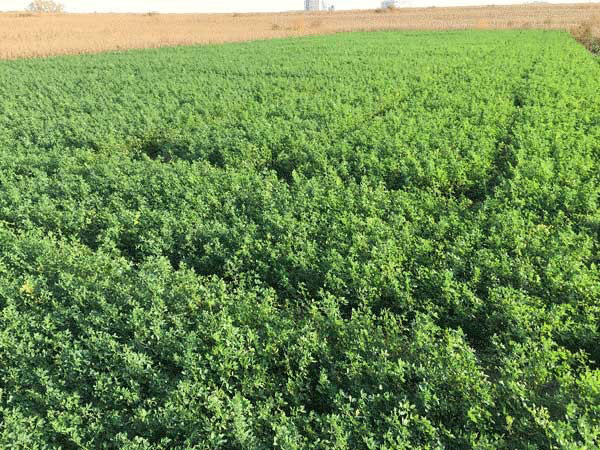Alfalfa will quit growing after the first hard freeze (when temperatures reach below 26°F), which in Kansas occurs on average around October 15, but can be as early as October 1 or late as November 1. The decision should be weather-based at this time of the year because the timing of the last two cuttings impacts the winter survival and productivity of the stand in the following year.
The last cutting, prior to fall dormancy, should be made based on expected crown regrowth rather than one-tenth bloom because of the decreasing photoperiod. The last cutting should be made so there will be 8 to 12 inches of foliage, or 4 to 6 weeks of growth time, before the first killing frost. This should allow adequate time for replenishment of root reserves. Which means the second to final cutting should occur around September 1.
At this stage of the growing season, alfalfa plants need to store enough carbohydrates to survive the winter. If root reserves are not replenished adequately before the first killing freeze in the fall, the stand is more susceptible to winter damage than it would be normally. That could result in slower greenup and early growth next spring, and in some cases stand loss due to winter kill. The potential of the alfalfa crop to grow new foliar tissue in the spring is greater with greater root reserves in the fall, thus root reserves this fall are the main driver of next crop’s yield and quality.
The final cutting should occur right after the first killing freeze, before too many of the leaves have dropped. Producers should be prepared to enter the fields as soon as soil moisture conditions allow. After a killing freeze, the remaining forage (if any) can be hayed safely. However, the producer should act quickly because the leaves will soon drop off.

Figure 1. Alfalfa stand with approximately 12 inches of top growth prior to winter dormancy. The last cut in this stand was performed early September, and this photo was taken late October. This stand will be hayed immediately following the first killing frost. Photo by Romulo Lollato, K-State Research and Extension.
Consider soil sampling alfalfa fields now
Late fall is also a great time of the year to soil sample alfalfa ground. This timing allows for an accurate assessment of available soil nutrients and provides enough time to make nutrient management decisions before the crop starts growing in the spring. Key soil tests include pH, phosphorus, and potassium, and to a lesser extent, sulfur and boron. In particular, potassium is highly related to winter survival so it’s important to make sure to have optimum range of potassium in soil before entering the winter. When sampling for immobile nutrients, sampling depth should be six inches, while mobile nutrients (sulfur) should be sampled to 24 inches. Based on the soil test, a fertility program can be established to assure nutrient replenishment and maintain hayfield productivity.
John Holman, Cropping Systems Agronomist, Southwest Research-Extension Center
jholman@ksu.edu
Romulo Lollato, Wheat and Forages Specialist
lollato@ksu.edu
Bruno Pedreira, Southeast Area Agronomist – Parsons
pedreira@ksu.edu
Tags: alfalfa forage dormancy last cutting